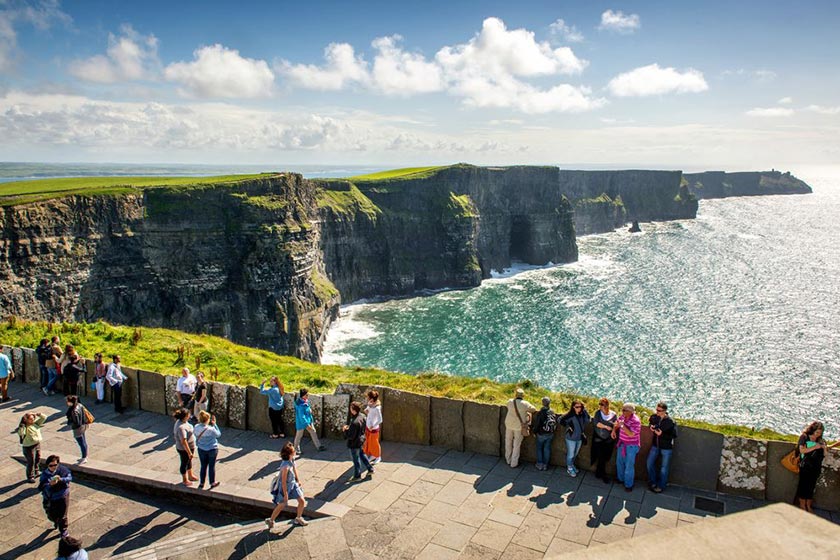Eight kilometres of cliffs rising to 200 metres overlooking the wild Atlantic. The cliffs were formed many millions of years ago and the the sea has been pounding on them ever since. From the Cliffs, you get a view of the Arran Islands and lots of sea birds as they use the wind to glide up and down along the cliffs. The tour also takes you through the amazing landscape of the Burren, where limestone was exposed due to the action of Neolithic farmers five thousand years ago. Lots of photo stops, a nice place for lunch and maybe a pint in a local pub and you have a perfect day tour in this part of Ireland. You won’t be disappointed.
Cliffs of Moher with your own private driver guide
Featured on this tour

Dunguire Castle
Named after the owner of the original stronghold, King Guaire of Connaught, this is said to be the most photographed castle in Ireland. It was owned in the C16 by the Hynes family and has had many owners over the centuries. Legend has it that the lord of the castle was very generous even in the afterlife. It is said that if you stand in the entrance gateway and ask a question, you will have your answer by the end of the day.

Cliffs of Moher
The name ‘Moher’ is the Gaelic for ruin. The cliffs are 8km long and rise to over 200m above the Atlantic Ocean. They are made up of layers of sandstone and black schist. The site gets more than one million visitors per year and is home to 30 species of birds including Puffins during the breeding season. You can choose to walk along the cliffs to the north or the south but don’t worry, there is a wall to prevent you tumbling into the sea below!

The Burren
Covering 160 sq. km the landscape which is made of limestone looks like a pile of grey plates stacked on top of each other. The limestone was originally a limey mud seabed deposited 340m years ago in a series of distinct phases during the Carboniferous Period. It is 800m thick in some places there are significant caves located below the surface. The name comes from Gaelic ‘boirrean’ which means rock. Sometimes it is referred to as fertile rock due to the great variety of plants growing here.

Poulnabrone Dolmen
This is one of the iconic monuments of ancient Ireland. It dates from the neolithic age and is thought to be more than 5,000 years old. The capstone weights 1.5 tons and you can imagine the work involved in getting it to its location. During excavations the remains of at least 33 individuals, adults, children and infants both male and female, were found along with pieces of pottery and jewellery. It was used over a period of 1,300 years between 4,200 and 2,900 BC.

Corcomroe Abbey
Known as St. Mary of the Fertile Rock this abbey is located in a rich valley surrounded by rocky hills. It was founded by the Cistercians in 1194 and built by Donal Mór O’Brien, King of Thomond. There is an effigy of his grandson Conor O’Brien (d. 1268) in the chancel. The church was made smaller in the 15th century as the number of monks declined as it was not a rich abbey. The site consists of an entrance gate, the church with nave, chancel (lancet windows) & side isle and a possible infirmary or guesthouse.

Doolin
With a population of just 250 the village is famous for its music, its pubs and its craic (that’s fun, not the white stuff!). It is the departure point for ferries to the Arran Islands and for visits by boat to the Cliffs of Moher from the sea. It is a popular starting or finishing point for an energetic coastal walk to and from t he Cliffs of Moher. It is a quaint spot which has lots of opportunities for great photos to remind you of your visit to the west coast of Ireland. By the way, the pubs here serve great pints of Guinness!
What to expect
Professionally guided tour by Neal Doherty in a top spec Land Rover Discovery classified as a Limo. Expect an interesting and entertaining tour with lots of stories, history and anecdotes that you will remember and take home to your family and friends. Our tours are designated tours but if you have some subject or area in which you are particularly interested please let me know and I will tailor the tour to your needs.
- Rest stops and Tea/Coffee breaks.
- Lunch stop (not included in price).
- Plenty of photo opportunities.










